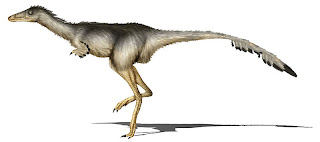For the last two weeks, we've been talking about mass extinctions (part 1 and part 2), and last week we introduced the Cretaceous-Palaeogene (AKA Cretaceous-Tertiary, K-T, or K-Pg) extinction. Of course this is the most famous mass extinction because this is the one that caused the end of the dinosaurs. This week, we'll go into the K-Pg mass extinction in a bit more detail.
The impact hypothesis
This is the most strongly supported hypothesis for what caused the mass extinction, and is generally supported by the majority of palaeontologists and scientists. At the very least, the occurrence of the impact is supported, although some people still debate whether it caused the extinction. How did this hypothesis come to be? It's actually quite an interesting story. In 1980, a team of scientists including physicists, geologists and chemists suggested that the extinction was caused by an impact from an extra terrestrial object (Alvarez et al. 1980). They found that the sediments at this time contained much larger amounts of an element called iridium than either before or after. Iridium is a very rare find on Earth, but is found in high concentration in meteors and asteroids. This led them to believe that an extra terrestrial impact occurred at the time of the extinction, and therefore caused the extinction. They predicted that object that collided with Earth would have been about 10 km in diameter, and would have caused a crater over 100 km wide. They also predicted that it would have hit the ocean, and caused large amounts of highly pressured sediment to be ejected into the atmosphere. They were able to identify very fine sediment and clay from this time that could be explained by a large amount of sediment being kicked up into the atmosphere and slowly settling. The catch: they did not have the crater.
At this point, some people thought the idea was a good one, but many people thought they were totally on the wrong track. Iridium can be caused from volcanic eruptions, and after all, they didn't have a crater. Then, in 1991, a crater was identified with a diameter of 180 km that is partially on the Yucutan Peninsula, but mainly in the Gulf of Mexico (Hildebrand et al. 1991). It was identified from studying sediment core samples that had been retrieved in oil exploration. This crater is called the Chicxulub crater, and appears to match the time of the K-Pg extinction.
 |
| Results of a NASA topography study showing the shape of the Chicxulub crater |
How does an impact cause a mass extinction?
There are several different stages of an impact that can cause extinction. First of all, any animals living close to the impact would have died instantly either by the impact itself, or by the high amount of pressure and subsequent shockwave. As the impact was partially in water, huge tsunamis would have occurred, wiping out anything living close to the coastline. The biggest problem, however, comes from the dust ejected into the atmosphere. It's hypothesized that such a large amount of sediment was ejected into the atmosphere that it would have blocked out the sunlight. This was further made worse by gas and aerosols going into the atmosphere and absorbing sunlight before it could reach the Earth. This may have occurred for up to 10 years, which means that anything that relies on photosynthesis (plants and small animals like phytoplankton) would die. Of course this causes a chain reaction, since herbivores would then die from starvation, and eventually carnivores would also die. It also may have caused global fires and acid rain.
 |
| Artists impression of some pterosaurs flying by the impact, which eventually would cause their extinction |
Volcanism as a cause
The leading alternative hypothesis of the K-Pg extinction stems from a huge volcanic eruption that occurred in what is now India, in what is called the Deccan Traps. There is an extremely large amount of basalt, a type of rock formed by lava, that can be found in this area. It is thought to have been caused by constant volcanic eruptions occurring from about 68 to 65 million years ago. It's thought that this could have caused similar problems to the impact, injecting large amounts of aerosols into the atmosphere. It also may have greatly increased the amount of carbon dioxide into the air, which may have had a greenhouse effect and caused global warming.
What really happened?
There is some debate that dinosaurs were already dying out before the end of the Cretaceous, and that the impact just finished them off. Other people suggest that the impact occurred earlier and could not have caused the extinction. Finally, some people think it most likely was caused by a combination of the impact and volcanism. Either way, the Earth was particularly volatile at this point in time and wouldn't have been a great place to live!
References and Links
Alvarez, L.W. et al. 1980. Extraterrestrial cause for the Cretaceous-Tertiary extinction. Science 208: 1095-1108.
Hildebrand, A.R. et al. 1991. Chicxulub crater: a possible Cretaceous/Tertiary boundary impact crater on the Yucutan Peninsula, Mexico. Geology 19: 867-871.









